Problems and Treatment of Cushing Syndrome: A Case Study Analysis
VerifiedAdded on 2021/04/21
|8
|2233
|220
Report
AI Summary
This report provides a comprehensive analysis of Cushing Syndrome, a disorder characterized by high cortisol levels. The report begins by defining the disorder and exploring its causes, including the overuse of corticosteroids and other factors like pituitary gland tumors, stress, and malnutrition. It then delves into the symptoms, such as weight gain (particularly in the face and upper back), fatigue, menstrual irregularities, and potential bone loss, as observed in the case study of Maureen, a patient with type 2 diabetes. The report further examines the various treatment options, including somatostatinergic and dopaminergic drugs, while also acknowledging their potential side effects. Additionally, the report outlines crucial nursing assessment steps to be followed within the first 24 hours of patient admission, encompassing patient history, general appearance, vital signs, and physical assessments. The report concludes by emphasizing the impact of Cushing Syndrome on a patient's physical, emotional, and financial well-being, underscoring the importance of comprehensive care and management.
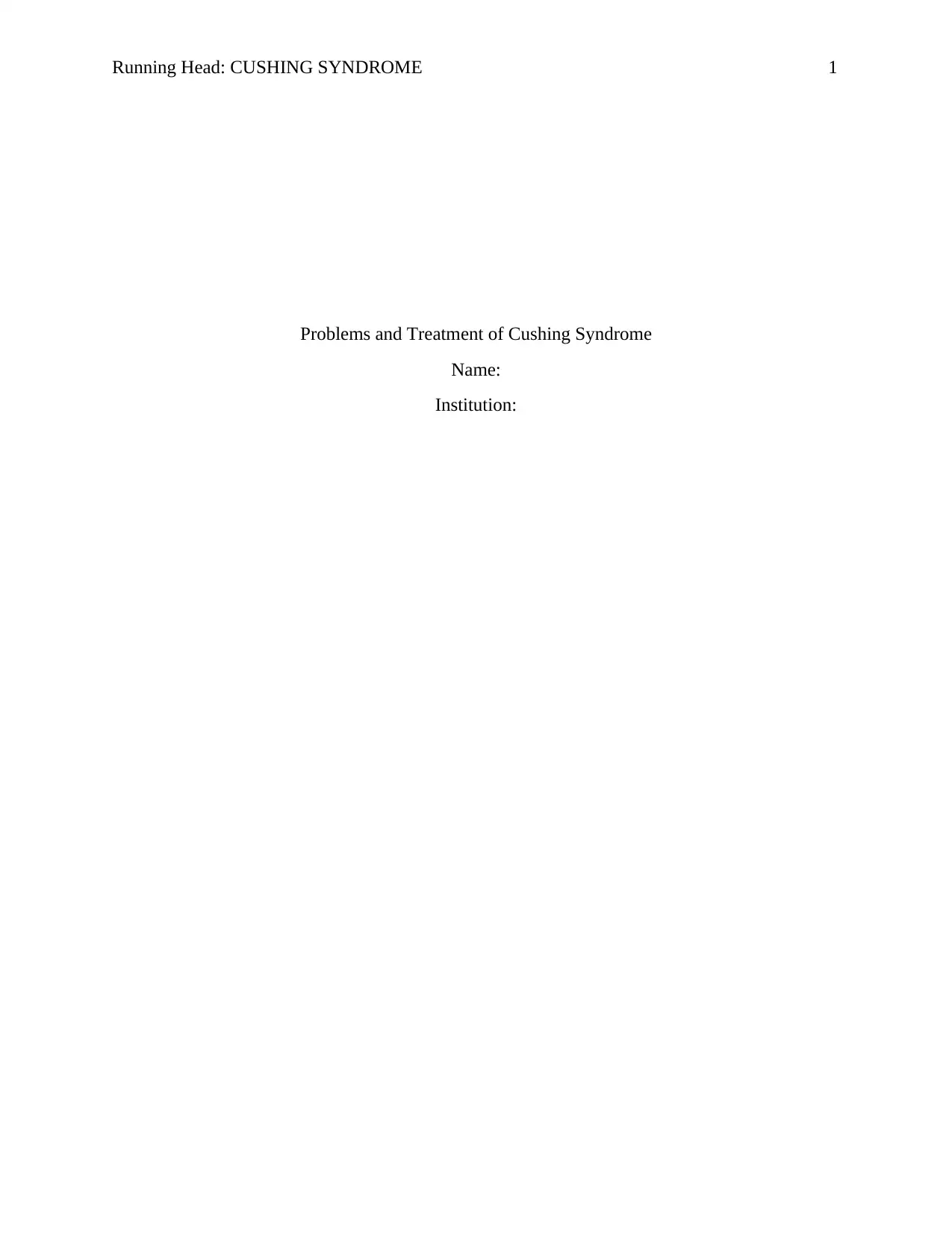
Running Head: CUSHING SYNDROME 1
Problems and Treatment of Cushing Syndrome
Name:
Institution:
Problems and Treatment of Cushing Syndrome
Name:
Institution:
Paraphrase This Document
Need a fresh take? Get an instant paraphrase of this document with our AI Paraphraser
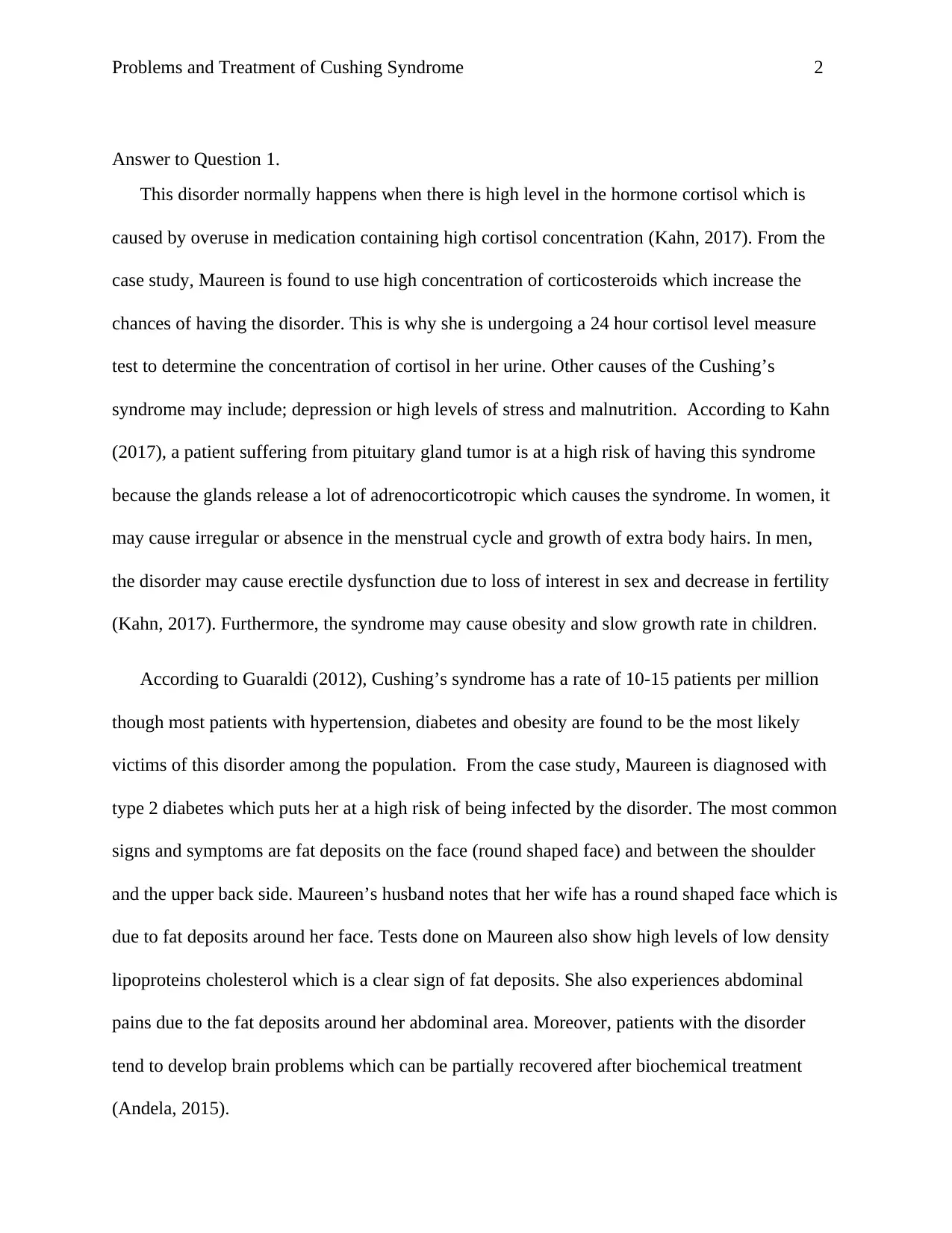
Problems and Treatment of Cushing Syndrome 2
Answer to Question 1.
This disorder normally happens when there is high level in the hormone cortisol which is
caused by overuse in medication containing high cortisol concentration (Kahn, 2017). From the
case study, Maureen is found to use high concentration of corticosteroids which increase the
chances of having the disorder. This is why she is undergoing a 24 hour cortisol level measure
test to determine the concentration of cortisol in her urine. Other causes of the Cushing’s
syndrome may include; depression or high levels of stress and malnutrition. According to Kahn
(2017), a patient suffering from pituitary gland tumor is at a high risk of having this syndrome
because the glands release a lot of adrenocorticotropic which causes the syndrome. In women, it
may cause irregular or absence in the menstrual cycle and growth of extra body hairs. In men,
the disorder may cause erectile dysfunction due to loss of interest in sex and decrease in fertility
(Kahn, 2017). Furthermore, the syndrome may cause obesity and slow growth rate in children.
According to Guaraldi (2012), Cushing’s syndrome has a rate of 10-15 patients per million
though most patients with hypertension, diabetes and obesity are found to be the most likely
victims of this disorder among the population. From the case study, Maureen is diagnosed with
type 2 diabetes which puts her at a high risk of being infected by the disorder. The most common
signs and symptoms are fat deposits on the face (round shaped face) and between the shoulder
and the upper back side. Maureen’s husband notes that her wife has a round shaped face which is
due to fat deposits around her face. Tests done on Maureen also show high levels of low density
lipoproteins cholesterol which is a clear sign of fat deposits. She also experiences abdominal
pains due to the fat deposits around her abdominal area. Moreover, patients with the disorder
tend to develop brain problems which can be partially recovered after biochemical treatment
(Andela, 2015).
Answer to Question 1.
This disorder normally happens when there is high level in the hormone cortisol which is
caused by overuse in medication containing high cortisol concentration (Kahn, 2017). From the
case study, Maureen is found to use high concentration of corticosteroids which increase the
chances of having the disorder. This is why she is undergoing a 24 hour cortisol level measure
test to determine the concentration of cortisol in her urine. Other causes of the Cushing’s
syndrome may include; depression or high levels of stress and malnutrition. According to Kahn
(2017), a patient suffering from pituitary gland tumor is at a high risk of having this syndrome
because the glands release a lot of adrenocorticotropic which causes the syndrome. In women, it
may cause irregular or absence in the menstrual cycle and growth of extra body hairs. In men,
the disorder may cause erectile dysfunction due to loss of interest in sex and decrease in fertility
(Kahn, 2017). Furthermore, the syndrome may cause obesity and slow growth rate in children.
According to Guaraldi (2012), Cushing’s syndrome has a rate of 10-15 patients per million
though most patients with hypertension, diabetes and obesity are found to be the most likely
victims of this disorder among the population. From the case study, Maureen is diagnosed with
type 2 diabetes which puts her at a high risk of being infected by the disorder. The most common
signs and symptoms are fat deposits on the face (round shaped face) and between the shoulder
and the upper back side. Maureen’s husband notes that her wife has a round shaped face which is
due to fat deposits around her face. Tests done on Maureen also show high levels of low density
lipoproteins cholesterol which is a clear sign of fat deposits. She also experiences abdominal
pains due to the fat deposits around her abdominal area. Moreover, patients with the disorder
tend to develop brain problems which can be partially recovered after biochemical treatment
(Andela, 2015).
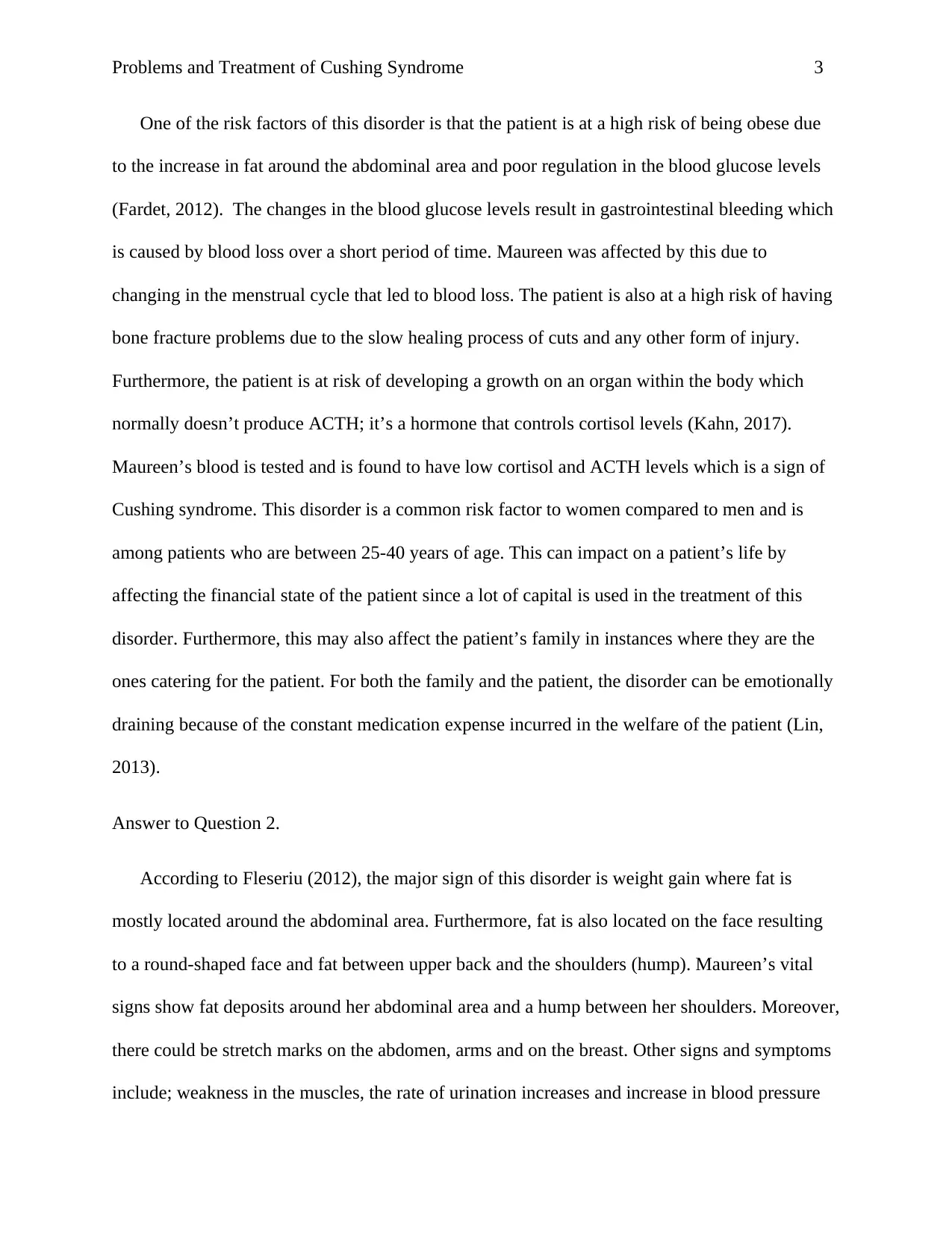
Problems and Treatment of Cushing Syndrome 3
One of the risk factors of this disorder is that the patient is at a high risk of being obese due
to the increase in fat around the abdominal area and poor regulation in the blood glucose levels
(Fardet, 2012). The changes in the blood glucose levels result in gastrointestinal bleeding which
is caused by blood loss over a short period of time. Maureen was affected by this due to
changing in the menstrual cycle that led to blood loss. The patient is also at a high risk of having
bone fracture problems due to the slow healing process of cuts and any other form of injury.
Furthermore, the patient is at risk of developing a growth on an organ within the body which
normally doesn’t produce ACTH; it’s a hormone that controls cortisol levels (Kahn, 2017).
Maureen’s blood is tested and is found to have low cortisol and ACTH levels which is a sign of
Cushing syndrome. This disorder is a common risk factor to women compared to men and is
among patients who are between 25-40 years of age. This can impact on a patient’s life by
affecting the financial state of the patient since a lot of capital is used in the treatment of this
disorder. Furthermore, this may also affect the patient’s family in instances where they are the
ones catering for the patient. For both the family and the patient, the disorder can be emotionally
draining because of the constant medication expense incurred in the welfare of the patient (Lin,
2013).
Answer to Question 2.
According to Fleseriu (2012), the major sign of this disorder is weight gain where fat is
mostly located around the abdominal area. Furthermore, fat is also located on the face resulting
to a round-shaped face and fat between upper back and the shoulders (hump). Maureen’s vital
signs show fat deposits around her abdominal area and a hump between her shoulders. Moreover,
there could be stretch marks on the abdomen, arms and on the breast. Other signs and symptoms
include; weakness in the muscles, the rate of urination increases and increase in blood pressure
One of the risk factors of this disorder is that the patient is at a high risk of being obese due
to the increase in fat around the abdominal area and poor regulation in the blood glucose levels
(Fardet, 2012). The changes in the blood glucose levels result in gastrointestinal bleeding which
is caused by blood loss over a short period of time. Maureen was affected by this due to
changing in the menstrual cycle that led to blood loss. The patient is also at a high risk of having
bone fracture problems due to the slow healing process of cuts and any other form of injury.
Furthermore, the patient is at risk of developing a growth on an organ within the body which
normally doesn’t produce ACTH; it’s a hormone that controls cortisol levels (Kahn, 2017).
Maureen’s blood is tested and is found to have low cortisol and ACTH levels which is a sign of
Cushing syndrome. This disorder is a common risk factor to women compared to men and is
among patients who are between 25-40 years of age. This can impact on a patient’s life by
affecting the financial state of the patient since a lot of capital is used in the treatment of this
disorder. Furthermore, this may also affect the patient’s family in instances where they are the
ones catering for the patient. For both the family and the patient, the disorder can be emotionally
draining because of the constant medication expense incurred in the welfare of the patient (Lin,
2013).
Answer to Question 2.
According to Fleseriu (2012), the major sign of this disorder is weight gain where fat is
mostly located around the abdominal area. Furthermore, fat is also located on the face resulting
to a round-shaped face and fat between upper back and the shoulders (hump). Maureen’s vital
signs show fat deposits around her abdominal area and a hump between her shoulders. Moreover,
there could be stretch marks on the abdomen, arms and on the breast. Other signs and symptoms
include; weakness in the muscles, the rate of urination increases and increase in blood pressure
⊘ This is a preview!⊘
Do you want full access?
Subscribe today to unlock all pages.

Trusted by 1+ million students worldwide
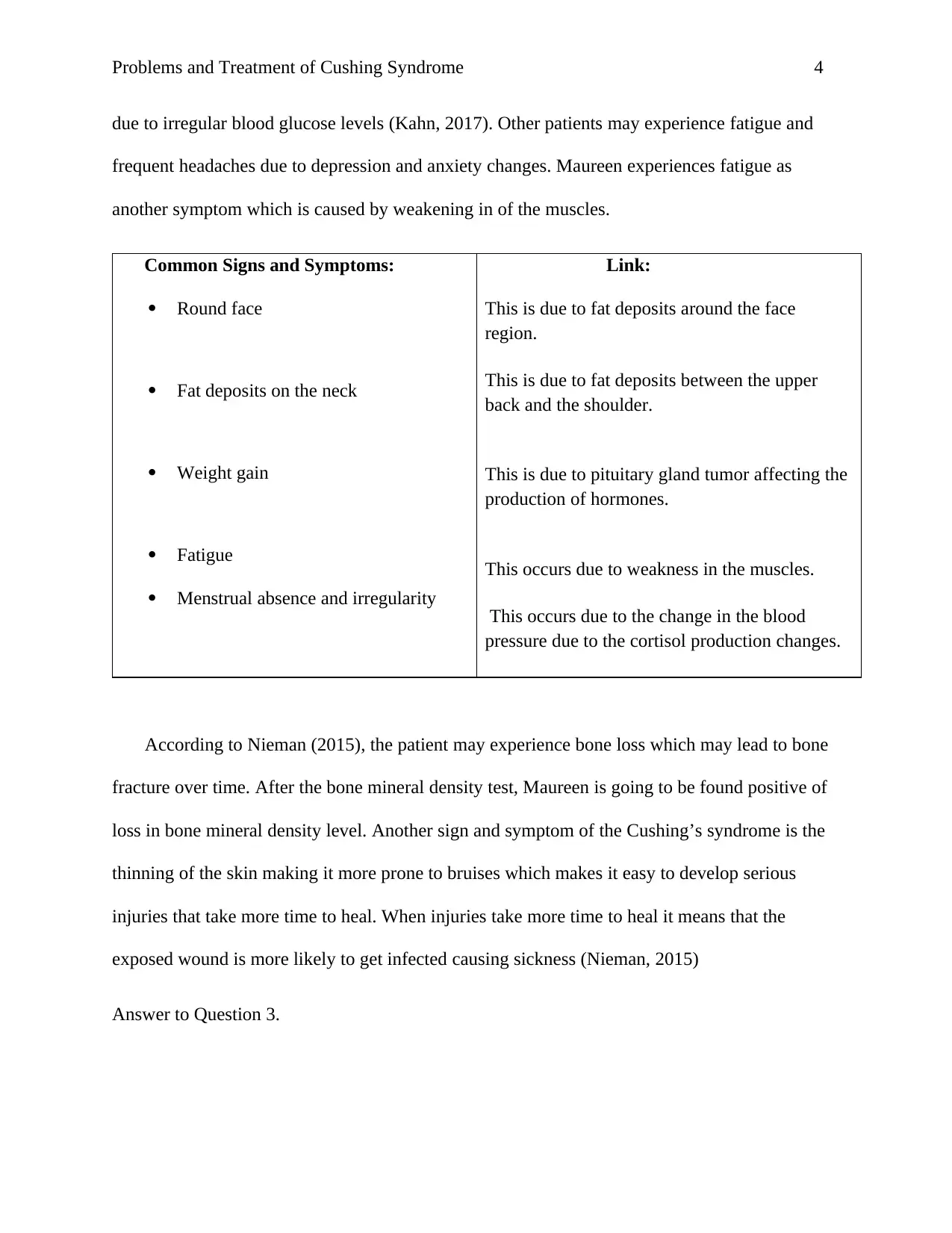
Problems and Treatment of Cushing Syndrome 4
due to irregular blood glucose levels (Kahn, 2017). Other patients may experience fatigue and
frequent headaches due to depression and anxiety changes. Maureen experiences fatigue as
another symptom which is caused by weakening in of the muscles.
Common Signs and Symptoms:
Round face
Fat deposits on the neck
Weight gain
Fatigue
Menstrual absence and irregularity
Link:
This is due to fat deposits around the face
region.
This is due to fat deposits between the upper
back and the shoulder.
This is due to pituitary gland tumor affecting the
production of hormones.
This occurs due to weakness in the muscles.
This occurs due to the change in the blood
pressure due to the cortisol production changes.
According to Nieman (2015), the patient may experience bone loss which may lead to bone
fracture over time. After the bone mineral density test, Maureen is going to be found positive of
loss in bone mineral density level. Another sign and symptom of the Cushing’s syndrome is the
thinning of the skin making it more prone to bruises which makes it easy to develop serious
injuries that take more time to heal. When injuries take more time to heal it means that the
exposed wound is more likely to get infected causing sickness (Nieman, 2015)
Answer to Question 3.
due to irregular blood glucose levels (Kahn, 2017). Other patients may experience fatigue and
frequent headaches due to depression and anxiety changes. Maureen experiences fatigue as
another symptom which is caused by weakening in of the muscles.
Common Signs and Symptoms:
Round face
Fat deposits on the neck
Weight gain
Fatigue
Menstrual absence and irregularity
Link:
This is due to fat deposits around the face
region.
This is due to fat deposits between the upper
back and the shoulder.
This is due to pituitary gland tumor affecting the
production of hormones.
This occurs due to weakness in the muscles.
This occurs due to the change in the blood
pressure due to the cortisol production changes.
According to Nieman (2015), the patient may experience bone loss which may lead to bone
fracture over time. After the bone mineral density test, Maureen is going to be found positive of
loss in bone mineral density level. Another sign and symptom of the Cushing’s syndrome is the
thinning of the skin making it more prone to bruises which makes it easy to develop serious
injuries that take more time to heal. When injuries take more time to heal it means that the
exposed wound is more likely to get infected causing sickness (Nieman, 2015)
Answer to Question 3.
Paraphrase This Document
Need a fresh take? Get an instant paraphrase of this document with our AI Paraphraser
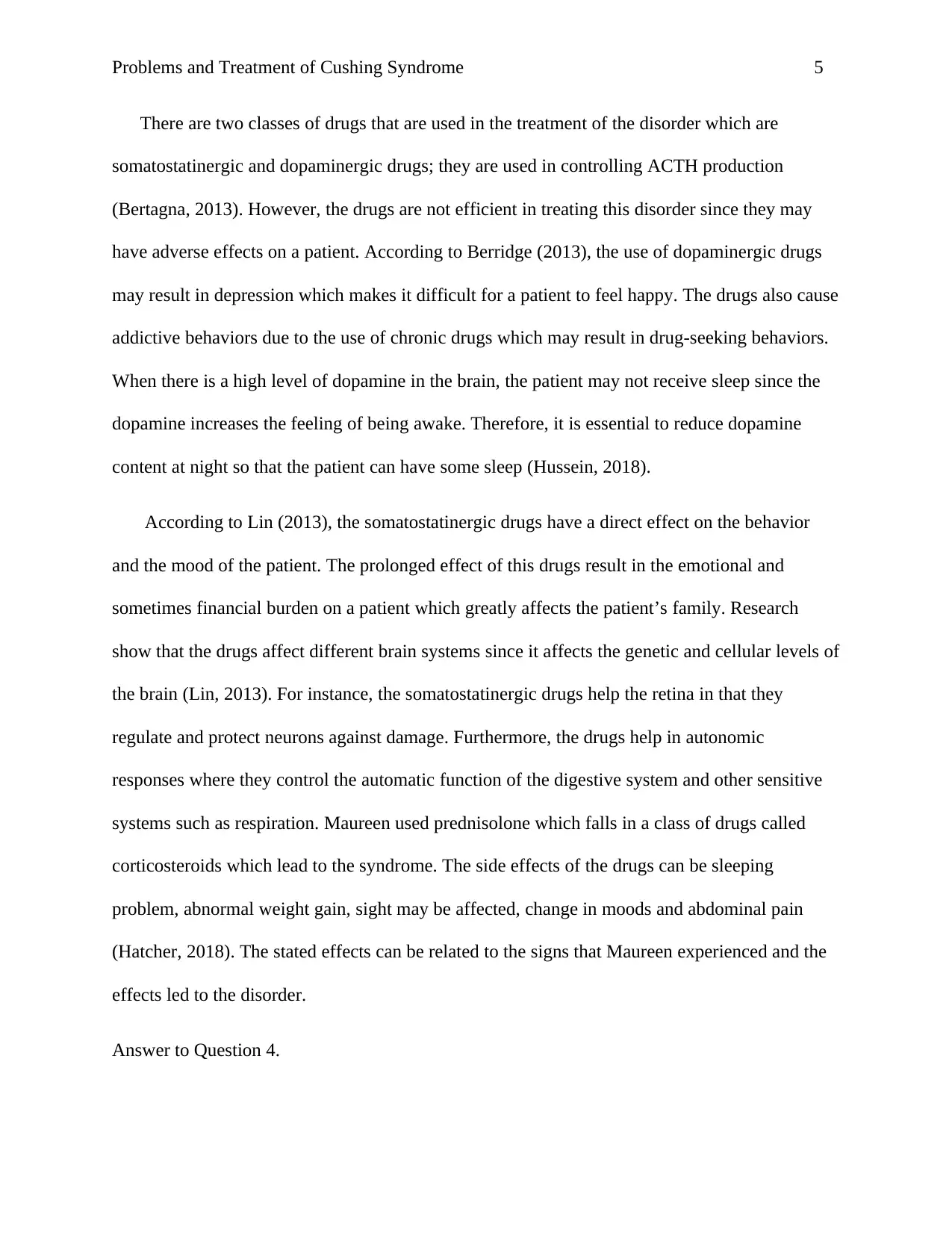
Problems and Treatment of Cushing Syndrome 5
There are two classes of drugs that are used in the treatment of the disorder which are
somatostatinergic and dopaminergic drugs; they are used in controlling ACTH production
(Bertagna, 2013). However, the drugs are not efficient in treating this disorder since they may
have adverse effects on a patient. According to Berridge (2013), the use of dopaminergic drugs
may result in depression which makes it difficult for a patient to feel happy. The drugs also cause
addictive behaviors due to the use of chronic drugs which may result in drug-seeking behaviors.
When there is a high level of dopamine in the brain, the patient may not receive sleep since the
dopamine increases the feeling of being awake. Therefore, it is essential to reduce dopamine
content at night so that the patient can have some sleep (Hussein, 2018).
According to Lin (2013), the somatostatinergic drugs have a direct effect on the behavior
and the mood of the patient. The prolonged effect of this drugs result in the emotional and
sometimes financial burden on a patient which greatly affects the patient’s family. Research
show that the drugs affect different brain systems since it affects the genetic and cellular levels of
the brain (Lin, 2013). For instance, the somatostatinergic drugs help the retina in that they
regulate and protect neurons against damage. Furthermore, the drugs help in autonomic
responses where they control the automatic function of the digestive system and other sensitive
systems such as respiration. Maureen used prednisolone which falls in a class of drugs called
corticosteroids which lead to the syndrome. The side effects of the drugs can be sleeping
problem, abnormal weight gain, sight may be affected, change in moods and abdominal pain
(Hatcher, 2018). The stated effects can be related to the signs that Maureen experienced and the
effects led to the disorder.
Answer to Question 4.
There are two classes of drugs that are used in the treatment of the disorder which are
somatostatinergic and dopaminergic drugs; they are used in controlling ACTH production
(Bertagna, 2013). However, the drugs are not efficient in treating this disorder since they may
have adverse effects on a patient. According to Berridge (2013), the use of dopaminergic drugs
may result in depression which makes it difficult for a patient to feel happy. The drugs also cause
addictive behaviors due to the use of chronic drugs which may result in drug-seeking behaviors.
When there is a high level of dopamine in the brain, the patient may not receive sleep since the
dopamine increases the feeling of being awake. Therefore, it is essential to reduce dopamine
content at night so that the patient can have some sleep (Hussein, 2018).
According to Lin (2013), the somatostatinergic drugs have a direct effect on the behavior
and the mood of the patient. The prolonged effect of this drugs result in the emotional and
sometimes financial burden on a patient which greatly affects the patient’s family. Research
show that the drugs affect different brain systems since it affects the genetic and cellular levels of
the brain (Lin, 2013). For instance, the somatostatinergic drugs help the retina in that they
regulate and protect neurons against damage. Furthermore, the drugs help in autonomic
responses where they control the automatic function of the digestive system and other sensitive
systems such as respiration. Maureen used prednisolone which falls in a class of drugs called
corticosteroids which lead to the syndrome. The side effects of the drugs can be sleeping
problem, abnormal weight gain, sight may be affected, change in moods and abdominal pain
(Hatcher, 2018). The stated effects can be related to the signs that Maureen experienced and the
effects led to the disorder.
Answer to Question 4.
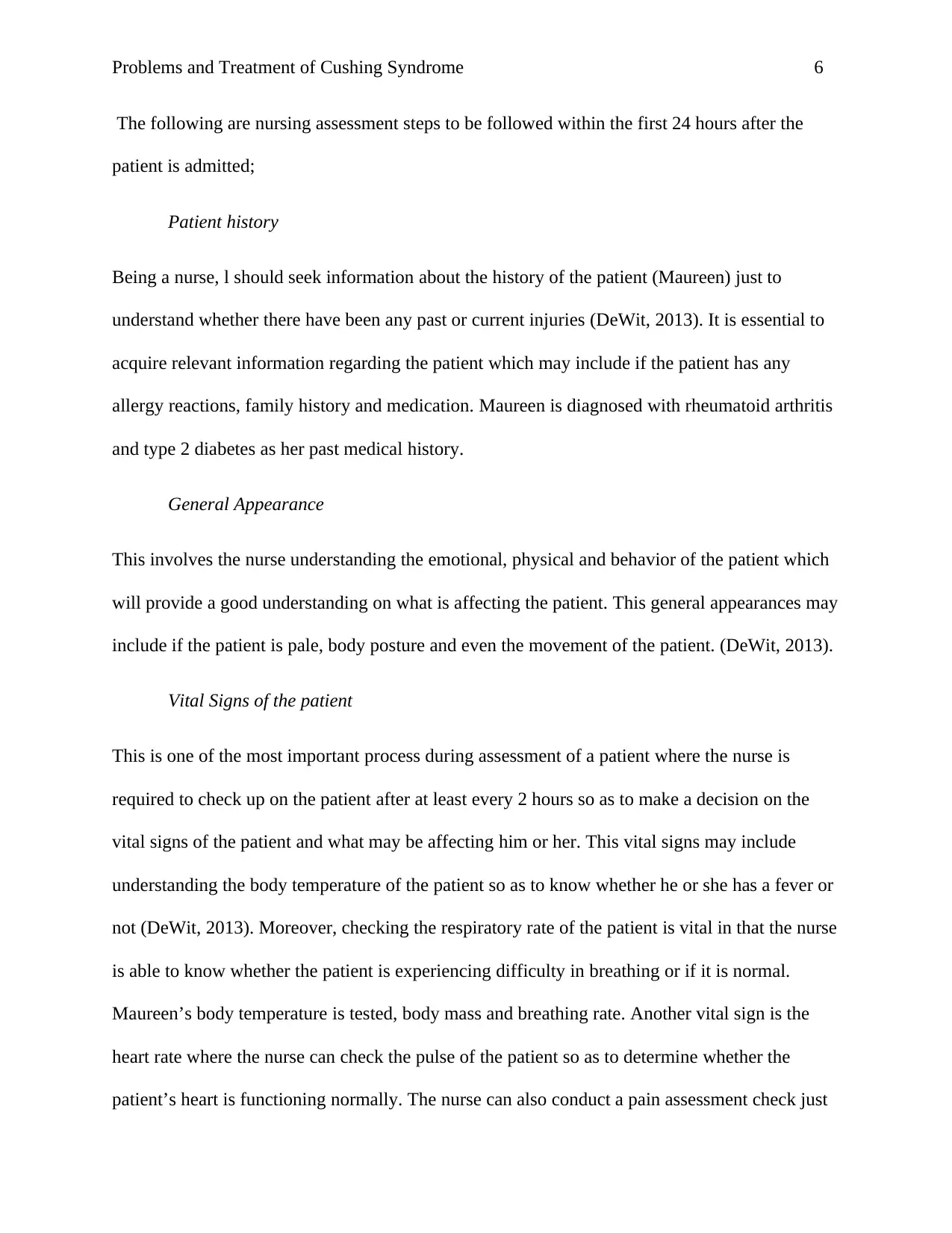
Problems and Treatment of Cushing Syndrome 6
The following are nursing assessment steps to be followed within the first 24 hours after the
patient is admitted;
Patient history
Being a nurse, l should seek information about the history of the patient (Maureen) just to
understand whether there have been any past or current injuries (DeWit, 2013). It is essential to
acquire relevant information regarding the patient which may include if the patient has any
allergy reactions, family history and medication. Maureen is diagnosed with rheumatoid arthritis
and type 2 diabetes as her past medical history.
General Appearance
This involves the nurse understanding the emotional, physical and behavior of the patient which
will provide a good understanding on what is affecting the patient. This general appearances may
include if the patient is pale, body posture and even the movement of the patient. (DeWit, 2013).
Vital Signs of the patient
This is one of the most important process during assessment of a patient where the nurse is
required to check up on the patient after at least every 2 hours so as to make a decision on the
vital signs of the patient and what may be affecting him or her. This vital signs may include
understanding the body temperature of the patient so as to know whether he or she has a fever or
not (DeWit, 2013). Moreover, checking the respiratory rate of the patient is vital in that the nurse
is able to know whether the patient is experiencing difficulty in breathing or if it is normal.
Maureen’s body temperature is tested, body mass and breathing rate. Another vital sign is the
heart rate where the nurse can check the pulse of the patient so as to determine whether the
patient’s heart is functioning normally. The nurse can also conduct a pain assessment check just
The following are nursing assessment steps to be followed within the first 24 hours after the
patient is admitted;
Patient history
Being a nurse, l should seek information about the history of the patient (Maureen) just to
understand whether there have been any past or current injuries (DeWit, 2013). It is essential to
acquire relevant information regarding the patient which may include if the patient has any
allergy reactions, family history and medication. Maureen is diagnosed with rheumatoid arthritis
and type 2 diabetes as her past medical history.
General Appearance
This involves the nurse understanding the emotional, physical and behavior of the patient which
will provide a good understanding on what is affecting the patient. This general appearances may
include if the patient is pale, body posture and even the movement of the patient. (DeWit, 2013).
Vital Signs of the patient
This is one of the most important process during assessment of a patient where the nurse is
required to check up on the patient after at least every 2 hours so as to make a decision on the
vital signs of the patient and what may be affecting him or her. This vital signs may include
understanding the body temperature of the patient so as to know whether he or she has a fever or
not (DeWit, 2013). Moreover, checking the respiratory rate of the patient is vital in that the nurse
is able to know whether the patient is experiencing difficulty in breathing or if it is normal.
Maureen’s body temperature is tested, body mass and breathing rate. Another vital sign is the
heart rate where the nurse can check the pulse of the patient so as to determine whether the
patient’s heart is functioning normally. The nurse can also conduct a pain assessment check just
⊘ This is a preview!⊘
Do you want full access?
Subscribe today to unlock all pages.

Trusted by 1+ million students worldwide
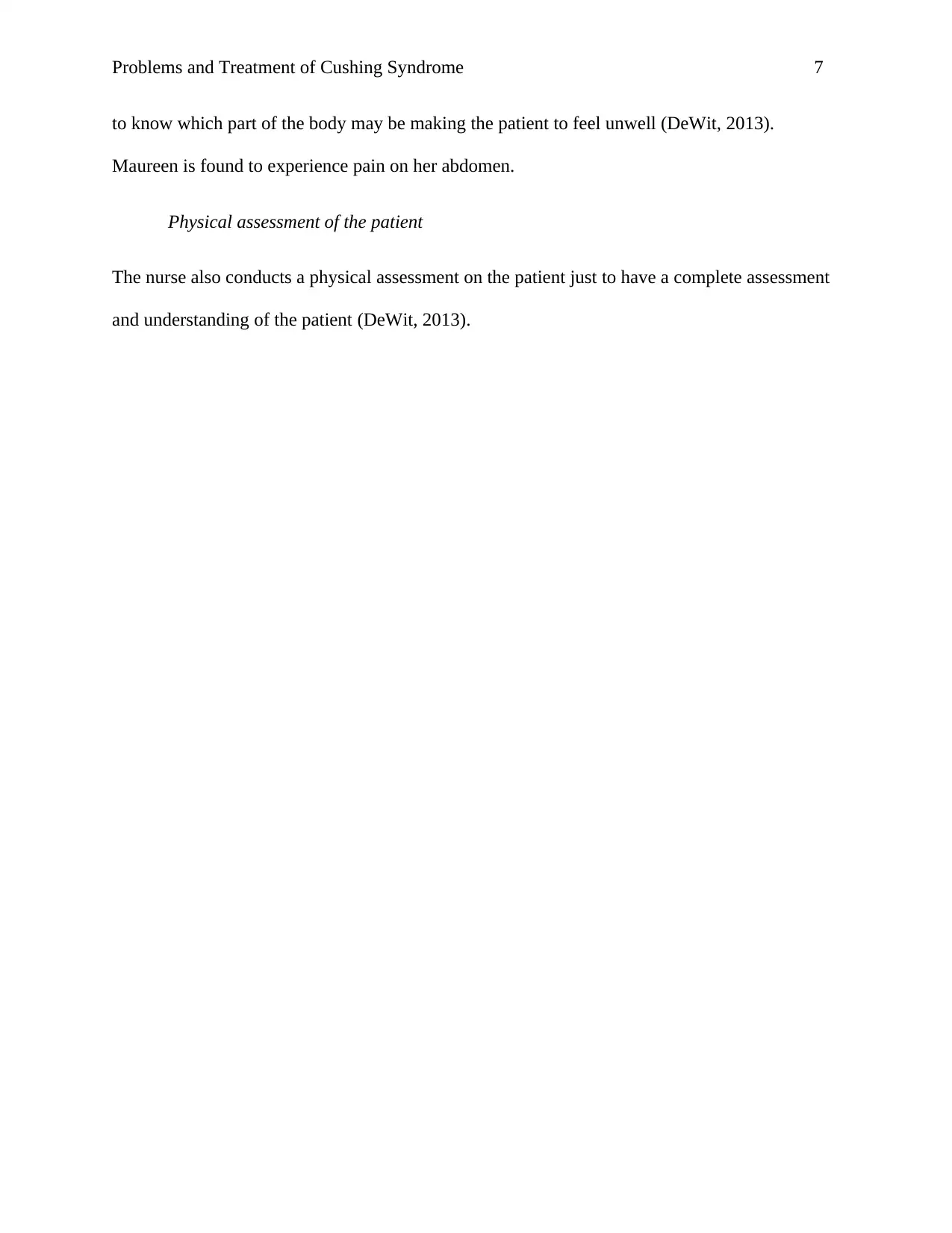
Problems and Treatment of Cushing Syndrome 7
to know which part of the body may be making the patient to feel unwell (DeWit, 2013).
Maureen is found to experience pain on her abdomen.
Physical assessment of the patient
The nurse also conducts a physical assessment on the patient just to have a complete assessment
and understanding of the patient (DeWit, 2013).
to know which part of the body may be making the patient to feel unwell (DeWit, 2013).
Maureen is found to experience pain on her abdomen.
Physical assessment of the patient
The nurse also conducts a physical assessment on the patient just to have a complete assessment
and understanding of the patient (DeWit, 2013).
Paraphrase This Document
Need a fresh take? Get an instant paraphrase of this document with our AI Paraphraser
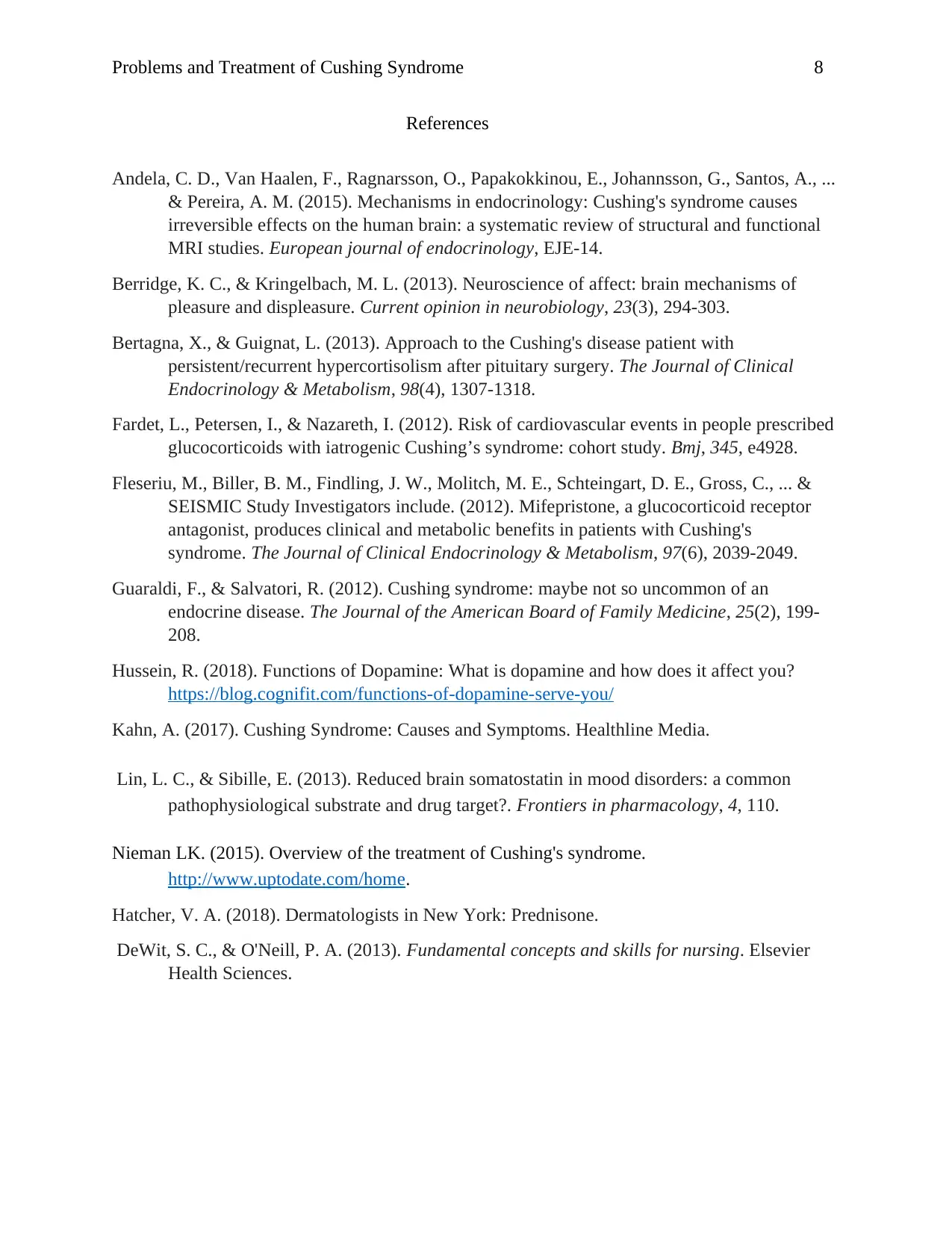
Problems and Treatment of Cushing Syndrome 8
References
Andela, C. D., Van Haalen, F., Ragnarsson, O., Papakokkinou, E., Johannsson, G., Santos, A., ...
& Pereira, A. M. (2015). Mechanisms in endocrinology: Cushing's syndrome causes
irreversible effects on the human brain: a systematic review of structural and functional
MRI studies. European journal of endocrinology, EJE-14.
Berridge, K. C., & Kringelbach, M. L. (2013). Neuroscience of affect: brain mechanisms of
pleasure and displeasure. Current opinion in neurobiology, 23(3), 294-303.
Bertagna, X., & Guignat, L. (2013). Approach to the Cushing's disease patient with
persistent/recurrent hypercortisolism after pituitary surgery. The Journal of Clinical
Endocrinology & Metabolism, 98(4), 1307-1318.
Fardet, L., Petersen, I., & Nazareth, I. (2012). Risk of cardiovascular events in people prescribed
glucocorticoids with iatrogenic Cushing’s syndrome: cohort study. Bmj, 345, e4928.
Fleseriu, M., Biller, B. M., Findling, J. W., Molitch, M. E., Schteingart, D. E., Gross, C., ... &
SEISMIC Study Investigators include. (2012). Mifepristone, a glucocorticoid receptor
antagonist, produces clinical and metabolic benefits in patients with Cushing's
syndrome. The Journal of Clinical Endocrinology & Metabolism, 97(6), 2039-2049.
Guaraldi, F., & Salvatori, R. (2012). Cushing syndrome: maybe not so uncommon of an
endocrine disease. The Journal of the American Board of Family Medicine, 25(2), 199-
208.
Hussein, R. (2018). Functions of Dopamine: What is dopamine and how does it affect you?
https://blog.cognifit.com/functions-of-dopamine-serve-you/
Kahn, A. (2017). Cushing Syndrome: Causes and Symptoms. Healthline Media.
Lin, L. C., & Sibille, E. (2013). Reduced brain somatostatin in mood disorders: a common
pathophysiological substrate and drug target?. Frontiers in pharmacology, 4, 110.
Nieman LK. (2015). Overview of the treatment of Cushing's syndrome.
http://www.uptodate.com/home.
Hatcher, V. A. (2018). Dermatologists in New York: Prednisone.
DeWit, S. C., & O'Neill, P. A. (2013). Fundamental concepts and skills for nursing. Elsevier
Health Sciences.
References
Andela, C. D., Van Haalen, F., Ragnarsson, O., Papakokkinou, E., Johannsson, G., Santos, A., ...
& Pereira, A. M. (2015). Mechanisms in endocrinology: Cushing's syndrome causes
irreversible effects on the human brain: a systematic review of structural and functional
MRI studies. European journal of endocrinology, EJE-14.
Berridge, K. C., & Kringelbach, M. L. (2013). Neuroscience of affect: brain mechanisms of
pleasure and displeasure. Current opinion in neurobiology, 23(3), 294-303.
Bertagna, X., & Guignat, L. (2013). Approach to the Cushing's disease patient with
persistent/recurrent hypercortisolism after pituitary surgery. The Journal of Clinical
Endocrinology & Metabolism, 98(4), 1307-1318.
Fardet, L., Petersen, I., & Nazareth, I. (2012). Risk of cardiovascular events in people prescribed
glucocorticoids with iatrogenic Cushing’s syndrome: cohort study. Bmj, 345, e4928.
Fleseriu, M., Biller, B. M., Findling, J. W., Molitch, M. E., Schteingart, D. E., Gross, C., ... &
SEISMIC Study Investigators include. (2012). Mifepristone, a glucocorticoid receptor
antagonist, produces clinical and metabolic benefits in patients with Cushing's
syndrome. The Journal of Clinical Endocrinology & Metabolism, 97(6), 2039-2049.
Guaraldi, F., & Salvatori, R. (2012). Cushing syndrome: maybe not so uncommon of an
endocrine disease. The Journal of the American Board of Family Medicine, 25(2), 199-
208.
Hussein, R. (2018). Functions of Dopamine: What is dopamine and how does it affect you?
https://blog.cognifit.com/functions-of-dopamine-serve-you/
Kahn, A. (2017). Cushing Syndrome: Causes and Symptoms. Healthline Media.
Lin, L. C., & Sibille, E. (2013). Reduced brain somatostatin in mood disorders: a common
pathophysiological substrate and drug target?. Frontiers in pharmacology, 4, 110.
Nieman LK. (2015). Overview of the treatment of Cushing's syndrome.
http://www.uptodate.com/home.
Hatcher, V. A. (2018). Dermatologists in New York: Prednisone.
DeWit, S. C., & O'Neill, P. A. (2013). Fundamental concepts and skills for nursing. Elsevier
Health Sciences.
1 out of 8
Related Documents
Your All-in-One AI-Powered Toolkit for Academic Success.
+13062052269
info@desklib.com
Available 24*7 on WhatsApp / Email
![[object Object]](/_next/static/media/star-bottom.7253800d.svg)
Unlock your academic potential
Copyright © 2020–2025 A2Z Services. All Rights Reserved. Developed and managed by ZUCOL.





